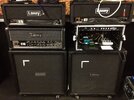LouWeed
Registrierter Benutzer
So, mein AOR brüllt wieder!!! Oh Gott was iss das nur für ein geiler Apparat!!!!!!!!! Hab jetzt auch mal die Gitarre komplett auf D gestimmt, statt nur Drop D 
ABER,
der Bass Boost ist einfach zu fett. Wenn ich den ziehe, erschlägst mich fast. Machst du ihn dann aus, klingt das Teil wie ne Blechtröte.
Hab einige Vorstufenröhren und ver. Kombinationen probiert (Auch mit ECC81) aber nichts zufrieden stellendes.
Daher mein Aufruf und Bitte an die Freaks mal den Schaltplan anzusehen, und mir vielleicht Tips geben wie ich den Bass Boost entschärfen kann
http://de.scribd.com/doc/6705447/Laney-AOR50-Schematic
Gruss

ABER,
der Bass Boost ist einfach zu fett. Wenn ich den ziehe, erschlägst mich fast. Machst du ihn dann aus, klingt das Teil wie ne Blechtröte.
Hab einige Vorstufenröhren und ver. Kombinationen probiert (Auch mit ECC81) aber nichts zufrieden stellendes.
Daher mein Aufruf und Bitte an die Freaks mal den Schaltplan anzusehen, und mir vielleicht Tips geben wie ich den Bass Boost entschärfen kann
http://de.scribd.com/doc/6705447/Laney-AOR50-Schematic
Gruss



 . Meine Kajüte, wie albern.
. Meine Kajüte, wie albern.